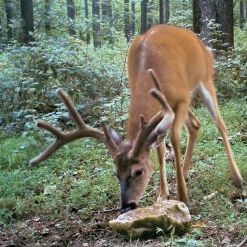 Right now, from late winter through spring, is the time to establish a mineral lick for deer.
Right now, from late winter through spring, is the time to establish a mineral lick for deer.
“Although deer only need very small quantities of trace minerals to express their full antler growth potential, without them in their diet, they simply can’t express their full genetic potential,” says whitetail scientist Grant Woods. Also, minerals provide a power boost for lactating does and the fetal development of fawns.
Here’s how to make a lick:
Deer will find your salt and minerals anywhere you put them out, but to maximize your efforts, look for a quiet spot on an oak ridge or in a creek bottom. A corner of a field or food plot is a good spot so long as it is hidden from view and away from foot and vehicle traffic.
I like to put a lick on an edge of cover where bucks hang out. A creek, pond, stock tank or other water source nearby is great because the deer can hit both the lick and the water on one trip.
Makes sense to make a lick near a well-used deer trail, where the animals can smell the salt in the minerals and veer over to hit it.
Old-school hunters used to dump minerals in a big rotten stump; we still do that if we can find a stump in the right spot, and it works.
Rake a spot 8 feet in diameter down to bare soil; rake and dig until you have a shallow depression, loosing up the dirt. Apply granulated minerals lightly and evenly over the area (don’t pile it). Rake some dirt back into the minerals and mix lightly.
If using a mineral block, set it in the middle of your cleared spot (or on a stump). I sometimes spread feed-grain salt around the block (the salt is what attracts deer).
Hang a trail camera on your mineral site so you can enjoy the deer and other wildlife that come to visit.
Check your minerals every month or so and replenish as needed. Swap out your camera cards each time you check the licks. Keep the “lick cam” running all summer and into the fall, because some bucks will keep coming back for months to check and dig.




